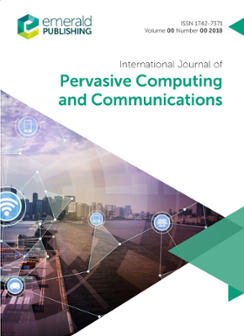International Journal of Pervasive Computing and Communications: Volume 18 Issue 5
Table of contents
On contact tracing in COVID-19 (SARS-CoV-2) pandemic using lowest common ancestor in m-ary data aggregation tree in the fog-computing enhanced internet of things
Ab Rouf Khan, Mohammad Ahsan ChishtiThe purpose of this study is to exploit the lowest common ancestor technique in an m-ary data aggregation tree in the fog computing-enhanced IoT to assist in contact tracing in…
Assessing nitrogen dioxide (NO2) impact on health pre- and post-COVID-19 pandemic using IoT in India
Sitharthan R., Shanmuga Sundar D., Rajesh M., Karthikeyan Madurakavi, Jacob Raglend I., Belwin Edward J., Raja Singh R., Kumar R.Corona Virus Disease 2019 (COVID-19) is a deadly virus named after severe acute respiratory syndrome coronavirus 2; it affects the respiratory system of the human and sometimes…
General public’s attitude toward governments implementing digital contact tracing to curb COVID-19 – a study based on natural language processing
Praveen S.V., Rajesh IttamallaGovernments worldwide are taking various measures to prevent the spreading of COVID virus. One such effort is digital contact tracing. However, the aspect of digital contact…
Challenges in successful implementation of Digital contact tracing to curb COVID-19 from global citizen’s perspective: a text analysis study
Praveen S.V., Rajesh Ittamalla, Dhilip SubramanianThe word “digital contact tracing” is often met with different reactions: the reaction that passionately supports it, the reaction that neither supports nor oppose and the one…
COVID-19 prediction and symptom analysis using wearable sensors and IoT
Karthickraja R., Kumar R., Kirubakaran S., Jegan Antony Marcilin L., Manikandan R.The purpose of the research work is to focus on the deployment of wearable sensors in addressing symptom Analysis in the Internet of Things (IoT) environment to reduce human…
Mobile application based speech and voice analysis for COVID-19 detection using computational audit techniques
Udhaya Sankar S.M., Ganesan R., Jeevaa Katiravan, Ramakrishnan M., Ruhin Kouser R.It has been six months from the time the first case was registered, and nations are still working on counter steering regulations. The proposed model in the paper encompasses a…
How optimistic do citizens feel about digital contact tracing? – Perspectives from developing countries
Praveen S.V., Rajesh Ittamalla, Dhilip SubramanianDespite numerous positive aspects of digital contact tracing, the implied nature of contact tracing is still viewed with skepticism. Those in favor of contact tracing often…
A case-study to examine doctors’ intentions to use IoT healthcare devices in Iraq during COVID-19 pandemic
Ameer Alhasan, Lukman Audah, Ishaq Ibrahim, Ammar Al-Sharaa, Ali Saadon Al-Ogaili, Jabiry M. MohammedSeveral countries have been using internet of things (IoT) devices in the healthcare sector to combat COVID-19. Therefore, this study aims to examine the doctors’ intentions to…
Localized automation solutions in response to the first wave of COVID-19: a story from Vietnam
Hoang-Long Cao, Huynh Anh Duy Nguyen, Trong Hieu Luu, Huong Thi Thu Vu, Diep Pham, Van Thi Ngoc Vu, Hoang Hai Le, Duy Xuan Bach Nguyen, Trong Toai Truong, Hoang-Dung Nguyen, Chi-Ngon NguyenCOVID-19 hits every country’s health-care system and economy. There is a trend toward using automation technology in response to the COVID-19 crisis not only in developed…
Smartphone-based electrochemical sensor for assessing COVID-19 infected patients
Ganesh Babu R., Balaji A., Kavin Kumar K., Sudhanshu Maurya, Saravana Kumar M.N.The purpose of the study is to highlight the potential of the sensor based smartphone in assessing the covid-19 cases. Coronavirus disease 2019 (COVID-19) is a noxious pandemic…
Impact of optimal scaling coefficients in bi-orthogonal wavelet filters on compressed sensing
Ashok Naganath Shinde, Sanjay L. Nalbalwar, Anil B. NandgaonkarIn today’s digital world, real-time health monitoring is becoming a most important challenge in the field of medical research. Body signals such as electrocardiogram (ECG)…
Trusted Secure Geographic Routing Protocol: outsider attack detection in mobile ad hoc networks by adopting trusted secure geographic routing protocol
Francis H. Shajin, Paulthurai RajeshThis study aims to evaluate the direct trust value for each node and calculate the trust value of all nodes satisfying the condition and update the trust value and value each…
Real-time data integration of an internet-of-things-based smart warehouse: a case study
Chelinka Rafiesta Sahara, Ammar Mohamed AamerCreating a real-time data integration when developing an internet-of-things (IoT)-based warehouse is still faced with challenges. It involves a diverse knowledge of novel…
Design and implementation of energy-aware cross-layer routing protocol for wearable body area network
Muniraju Naidu Vadlamudi, Asdaque Hussain M.D.A wireless body area network (WBAN) plays a crucial role in the health-care domain. With the emergence of technologies like the internet of things, there is increased usage of…
Intrinsic interference suppressed FBMC QAM for MU-MIMO systems in computing and communications
Shobha Y.K., Rangaraju H.G.In order to optimize BER and to substantiate performance measures, initially, the filter bank multicarrier (FBMC) quadrature amplitude modulation (QAM) performance metrics are…
A novel deep learning approach for tracking with soft computing technique
Krishna Mohan A., Reddy P.V.N., Satya Prasad K.In the community of visual tracking or object tracking, discriminatively learned correlation filter (DCF) has gained more importance. When it comes to speed, DCF gives the best…

ISSN:
1742-7371Online date, start – end:
2005Copyright Holder:
Emerald Publishing LimitedOpen Access:
hybridEditor:
- Lizzy Seal